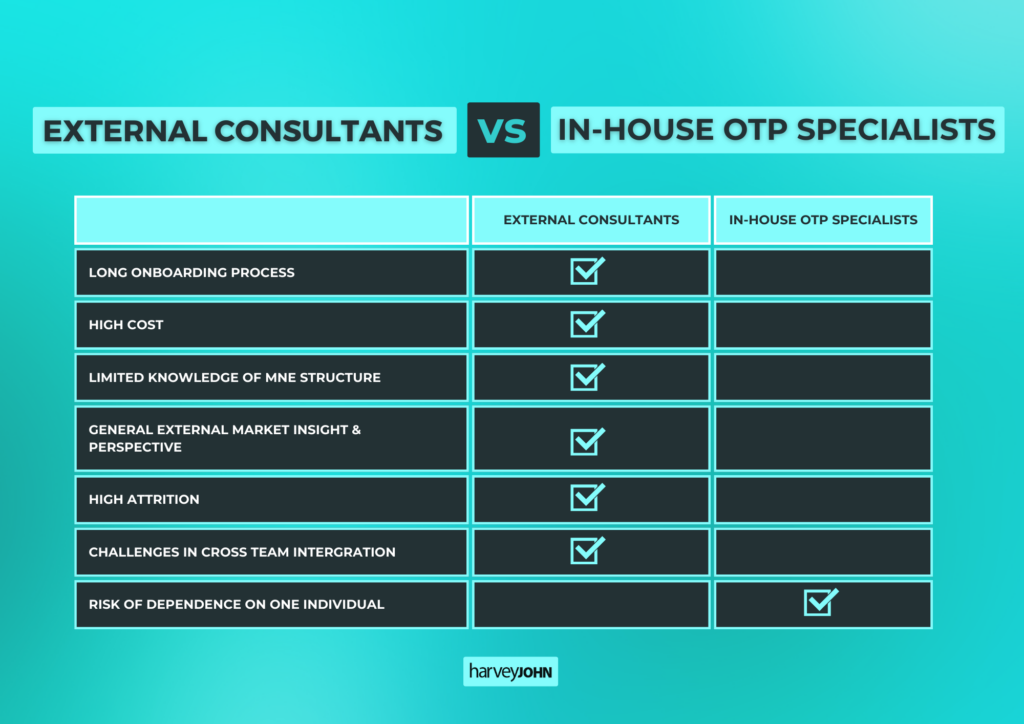Harvey John
Unit 2 Ferry Wharf
Hove Enterprise Centre
Basin Road North
Portslade, East Sussex
BN41 1BD
Mastering the intricacies of Operational Transfer Pricing (OTP) is now a non-negotiable for companies striving for financial efficiency and global compliance. The search for innovative solutions is on the rise.
What is OTP and why is it relevant?
OTP is the art of managing transfer pricing data, processes, and governance using cutting-edge technology. Picture this: a well-executed OTP program seamlessly aligns transfer pricing requirements with business goals. It’s the secret sauce to compliance, a simplifier of complex processes, a harbinger of strategic insights, and a catalyst for well-informed decision-making in the C-suite.
And even better – OTP is not just for transfer pricing. It’s a versatile tool with use cases in finance, supply chain, treasury, regulatory matters, and executive-level decision-making.

The lead-up to OTP solutions
In the evolution towards robust transfer pricing solutions, multinationals have traditionally leaned on ERP systems to oversee business operations. However, these conventional systems have demonstrated limitations in effectively managing transfer pricing processes. This inadequacy has prompted organisations to resort to manual methods or external tools, which, in the face of escalating transfer pricing regulations and heightened scrutiny from tax authorities, are proving increasingly unsustainable.
The landscape underwent a significant shift with the emergence of the OECD’s Base Erosion and Profit Shifting (BEPS) project and the introduction of Pillar Two. These developments have not only heightened the scrutiny surrounding transfer pricing but have also underscored the critical importance for organisations to align their business practices with transfer pricing compliance. In response to this evolving scenario, automation and technology solutions have taken center stage, providing a streamlined approach to managing substantial volumes of data while ensuring compliance.
Furthermore, the migration of ERP systems to the cloud has presented an opportunistic moment to reconfigure financial data structures. This restructuring aims to align with transfer pricing calculations and corresponding reporting requirements. Using tech advancements, organisations boost operational efficiency and navigate transfer pricing compliance complexities in today’s business environment.
Do you bring OTP in-house or outsource it?
After seeking advice from multiple OTP experts to understand the benefits of having an in-house OTP specialist compared to relying on external consultants.
Borys Ulanenko, a Transfer Pricing expert and founder of ArmsLength AI, and advisor to Aibidia, outlines the three key advantages of having an in-house OTP specialist:
- Consistency, continuity, and in-depth understanding of the business – an in-house OTP person will know the OTP set-up inside out and ensure the knowledge and control stay within the company. Big4 advisors tend to come and go, while an in-house person will ensure ownership.
- Cost-effectiveness – Big4 OTP projects tend to be expensive and may hook the company for ongoing support (especially if the set-up is technically sophisticated). Having an in-house person may reduce initial set-up and ongoing support costs.
- Real-time process, integration with other teams – achieving this while using external advisors is pretty challenging.
Borys Ulanenko has, however, stressed that we should be cautious of creating an over-reliance on a single in-house figure fulfilling this role and that a contingency plan is needed. As such, ensuring “that all the processes are well-documented” and there is clear technology and human system in place, as opposed to just manual spreadsheets.

Dr Frank Schoeneborn, the Global Head of EXA’s Operational Transfer Pricing Software also shared his insights:
“Many aspects seem to be critical when it comes to the decision of letting others do a managed service in operational transfer pricing. Onboarding external consultants to the business dynamics as well as business and process knowledge incl. ERP landscape is just the first step. For efficiency gains to be realised from outsourcing operational TP activities, it needs documenting and explaining existing processes, to agreeing new target operating procedures e.g for P&L segmentation, forecasting and TP setting incl. monitoring performance to what degree these steps have been successfully and timely completed. Even with professional OTP technology used to automate data gathering and data computation, there is a large risk of creating additional layers of management and coordination as there can be some doubt, if an external service provider is really taking decision what and why to change prices in daily business operations significantly influencing financial results. There can be some doubt, to what degree operational TP management activities can be outsourced in the view of competency as well. In the field of operational TP, MNEs need cross functional experts being able to speak business language as well as the terms of international tax from a compliance perspective.
What about OTP software?
Advanced software manages OTP complexities, including data collection, compliance, automation, real-time adjustments, profitability analysis, and cloud solutions. Used correctly, you could say goodbye to relying on spreadsheets.
Dr. Frank Schoeneborn emphasises the critical need for professional OTP software, highlighting the limitations of spreadsheets.
He emphasises managing software onboarding, training, data, and system access, addressing technical needs and security, paving the way for specialised OTP operations.
The critical role of an OTP specialist
The perspectives of both experts show that implementing OTP is an intricate process, requiring careful consideration of various factors to ensure smooth operations.
Consequently, securing the right individual for an OTP team is essential for successful implementation, enabling effective risk monitoring, opportunity identification, and comprehensive reporting to both internal and external stakeholders. This isn’t just hiring another team member; it’s securing the right individuals essential for a successful OTP implementation, people who’ll envision real-time scenario simulations, modeling logistics costs, calculate carbon footprints, and providing insights to the C-suite that will make heads turn.
In summary, successful OTP implementation will allow a business to:
- Perform real-time scenario simulations and financial projections for supply chain movements and broader business restructures.
- Model supply chain and logistics costs, including customs and duties.
- Calculate the carbon footprint of the supply chain and compare it to Environment, Social, and Governance (ESG) targets.
- Model returns against specific regulatory requirements, such as liquidity and capital ratios in the financial services industry.
- Provide comprehensive insights to the C-suite for business monitoring and accurate support for strategic operational decisions.
If you’re a tax or finance leader who is looking to get a handle on your in-house transfer pricing capabilities, then reach out to our specialist TP recruiter, Ewa Milner-Walker, for more information.
Author

Prior to joining the recruitment industry, Ewa had a career in real estate in New York City & London. She prides herself on working closely with clients and candidates to help them to find the best match for their requirements and career objectives.
Ewa is happy to converse in English, German, Italian as well as her native Polish.

